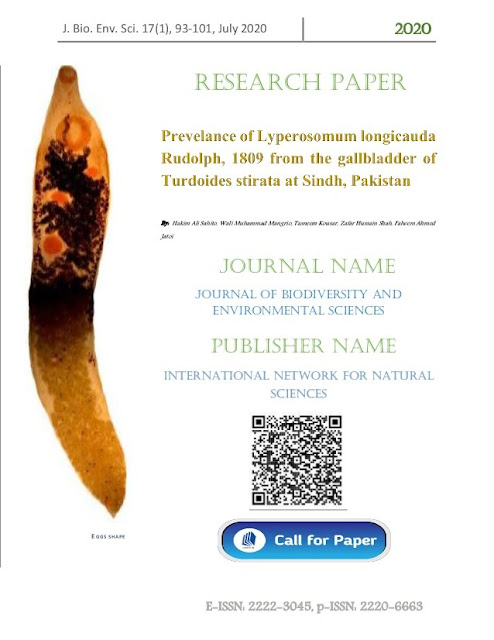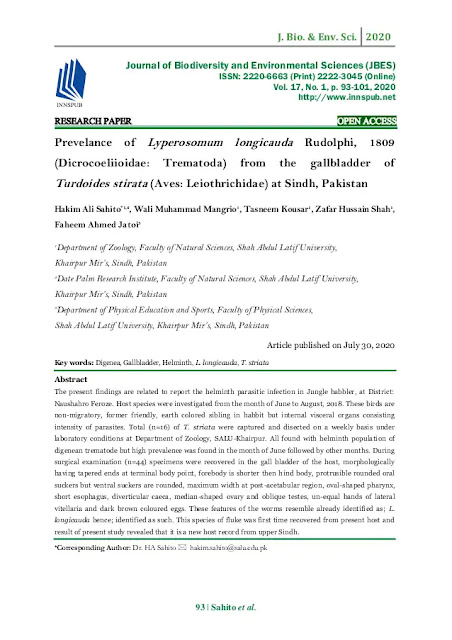Mr. Hakim Ali Sahito, Wali Muhammad Mangrio, Tasneem Kousar, Zafar Hussain Shah, from the Department of Zoology, Faculty of Natural Sciences, Shah Abdul Latif University, Khairpur Mir’s, Sindh, Pakistan, and Mr. Faheem Ahmed Jatoi, from the Department of Physical Education and Sports, Faculty of Physical Sciences, Shah Abdul Latif University, Khairpur Mir’s, Sindh, wrote a research paper entitled “Prevelance of Lyperosomum longicauda Rudolphi, 1809 (Dicrocoeliioidae: Trematoda) from the gallbladder of Turdoides stirata (Aves: Leiothrichidae) at Sindh, Pakistan.” This research work was published by the Journal of Biodiversity and Environmental Sciences | JBES under volume 17, July issue 2020. Let’s get some knowledge about this research.
Abstract
The present findings are related to report the helminth parasitic infection in Jungle babbler, at District: Naushahro Feroze. Host species were investigated from the month of June to August, 2018. These birds are non-migratory, former friendly, earth colored sibling in habbit but internal visceral organs consisting intensity of parasites. Total (n=16) of T. striata were captured and disected on a weekly basis under laboratory conditions at Department of Zoology, SALU-Khairpur. All found with helminth population of digenean trematode but high prevalence was found in the month of June followed by other months. During surgical examination (n=44) specimens were recovered in the gall bladder of the host, morphologically having tapered ends at terminal body point, forebody is shorter then hind body, protrusible rounded oral suckers but ventral suckers are rounded, maximum width at post-acetabular region, oval-shaped pharynx, short esophagus, diverticular caeca, median-shaped ovary and oblique testes, un-equal bands of lateral vitellaria and dark brown coloured eggs. These features of the worms resemble already identified as; L. longicauda hence; identified as such. This species of fluke was first time recovered from present host and result of present study revealed that it is a new host record from upper Sindh.
Related articles
Introduction
The birds are great valuable gift of almighty Allah, their colourful plumage attract the people, they are charming as sweet voices produce during early morning time, they having high economic value and serve as plant pollinators (Elon and Fred, 1924), found close association with humans.
The birds are reducing day by day due to urbanization, loss of habitat, climatic changes and vast application of pesticides also birds harbor a diversity of both endoparasites and ectoparasites cause deadly disease to their hosts and propagate to neighbouring livelihood (Akcakaya, 1990).
Trematodes parasites especially threat to Passeriformes caused significant living losses (Chung et al., 1995). The trematode belongs to family Dicrocoeliioidae, Eucotylidae and Rencicolidae cause great harm to the kidney and gall bladder, bile duct of the wild and domestic aves (Kanev et al., 2002). Jungle babbler is being omnivorous to their feeding behaviour bare parasitic worms and infestation depends availability of food source (Kyi and Poon, 1987). T. striata severely infected by numerous fluctuations of internal visceral helminths. In Pakistan there is no research documentary on the systematic studies of helminth parasites on T. striata and the main aim and motivation of present research work to findout the helminthological burden, parasitic identification and formulate systematic studies due to this reason T. straita agro-friendly species of bird selected as model for research and authors became strongly wilful on carryout experimental research to find out the prevalence of parasites from the internal visceral organs of host species.
Original Source of the Articles: J. Bio. Env. Sci. 17(1), 93-101, July 2020.
Reference
Akcakaya HR. 1990. Bald ibis Geronticus eremita population in turkey. An evaluation of captive breeding project for reintroduction. Biological Conservation 51, 225-237.
Ali S, Ripley SD. 1996. Handbook of the birds of India and Pakistan. Oxford University Press 6, 224-230.
Andrew MI, Naik RM. 1965. Structural basis of the change of eye colour of the Jungle Babbler, Turdoides striatus, during post-embryonic development. Indian Journal of Ornithilogy 3, 72-74.
https://en.wikip edia.org/ wiki/Jungle_babbler
Bilqees FM, Khan A. 2005. Two New Helminth Parasites from Pakistan, with Redescription of the Acanthocephalan Centrorhynchus fasciatum (Westrumb, 1821) Pakistan Journal of Zoology 37, 257-263.
Birmani NA, Dharejo AM, Khanmm. 2008. Echinostoma atrae, New species (Digenea: Echinostomatidae) in Black Coot, Fulica atra (Aves: Rallidae) of Manchhar Lake, Sindh, Pakistan) Pakistan Journal of Zoology 40, 379-383.
Channa MA, Khanmm, Sheikh AA, Dharejo AM. 2009. Echinochasmus jamshorensi, new species (Trematoda: Echinostomatidae) from Pond Heron, Ardeola grayii (Aves: Ardeidae) of Jamshoro, Sindh, Pakistan. Proceeding of Parasitology 48, 151-158.
Chittampalli MB, Bhatkhande PN. 1993. Hansdev’s Mrigpakeshi Shastra, M.S. Board of Literature and Culture, Mumbai, India 1, 279.
Chung DI, Moon CH, Knong HH, Chai DW, Lim DK. 1995. The first human case of Clinostomum complanatum (Trematode: Clinostomidae) infection in Korea. Korean Journal of Parasitoly 13, 219-223.
Daniels RJR, Joshi ΝV, Gadgil Μ. 1992. On the relationship between bird species richness and woody plant species diversity in Uttara Kannada district of south India. Proceedings of the academyof sciences of the United States of America 89, 5311-5315
Das SN, Ghazi RR. 2010. Lubens sindhensis, sp. n. (Trematoda: Dicrocoeliidae) from a new host phylloscopustytleri (Brooks) in Sindh, Pakistan. Proceedings of Parasitology 49, 49-55.
Denton JF, Krissinger WA. 1975. Lyperosomum byrdi sp.n. (Digenea: Dicrocoeliidae) from the Rufous-sided towhee, Pipilo erythrophthalmus (L.) with a revised synopsis of the genus. Proceedings of the helminthological societyof Washington 38-42.
Dharejo AM, Bilqees FM, Khanmm. 2007. Echinochasmus mohiuddini, new species (Trematoda: Echinostomatidae) from Paddy Bird Ardeola grayii (Ardeidae) of Hyderabad, Sindh, Pakistan. Pakistan Journal of Zoology 39, 285-288.
Drago FB, Lunaschi LI. 2010. Digenea, Strigeidae, Australapatemon Canadensis Dubois and Rausch, 1950: First record in South America and a new host record. Check List 6, 382-384.
Edurado SL, Carmelito GB. 2003. New species and new records of trematode parasites of Philippine wild birds. Philippine Journal of Veterinary Medicine 40, 66-78.
Elon EB, Fred DJ. 1924. The Helminth parasites of birds. I. A Review of the trematode genus Tanaisia Skrjabin. The Americam Midle and Naturalists 34, 32-57.
Fischthal HJ, Kuntz ER. 1973. Brachylaimid and Dicrocoeliid Trematodes of birds from Palawan Island, Philippines. Proceedings of the helminthological societyof Washington 40, 11-22.
Fischthal JH, Kuntz RE. 1974. Brachylaimid and Dicrocoeliid trematodes of birds from North Borneo (Malaysia). Proceedings of the helminthological societyof Washington 40, 94-104.
Fotedar DN, Raina MK. 1965. On a new species of the trematode genus Lyperosomum Looss, 1899 from Corvus monedula soemmeringii common jackdaw in Kashmir. Indian Journal of Helminthology 17, 54-62.
Gaston AJ. 1977. Social behaviour within groups of jungle babblers, Turdoides striatus. Animal Behaviour 25, 828-848.
Ghazi RR, Khan A, Sayed M. 2013. Paramonostomum bilqeesae, new species (Trematoda: Notocotylidae) from Common Teal (Anas crecca L.) in Sindh. Pakistan Journal of Zoology 45, 843-845.
Gibson DI, Jones A. 2008. Keys to the Trematoda, CABI, CAB International, Wallingford 3, 591-594.
Gmelin. 1960. New species malaysiae. Proceedings of the helminthological society of Washington 42, 101-103.
Hubalek Z. 2004. An annotated checklist of pathogenic microorganisms associated with migratory birds. Journal of Wildlife Diseases 40, 639-659.
John JL. 1995. Parasites and the avian spleen: helminths. Biologicla Journal of the Linnean Society 54, 87-106.
Kanev V, Fried B, Gibson DI, Jones A, Bray RA. 2002. (Eds.), Keys to the Trematoda. 1CABI, CAB International, Wallingford 147-153.
Kyi KK, Poon SK. 1987. Prevalence of Helminth parasites of house crow (Corvus splendens Vieillot) from the Kelang District of peninsular Malaysia. Folia Parasitologica 34, 347-355.
Mangrio WM, Sahito HA, Ruk M, Shah ZH, Kanher KA. 2016. Impact of cestode Helminth, Hymenolepis spp. (Weinland, 1858) in Jungle babbler bird. 36th Zoological Conf. (International) held on 16-18, Feb. 2016.
Nadeem M, Khan MN, Iqbal Z, Sajid MS, Arshad K, Yaseen M. 2007. Determination influencing prevalence of louse infestation on layers of distriact Faisalabad-Pakistan. British Poultry Science 38(5), 546-550.
Nice CS. 1994. The dissemination of human infectious disease by birds. Reviews in Medical Microbiology 5, 191-198.
Ripley SD. 1969. The name of the Jungle Babbler Turdoides striatus (Aves) from Orissa. Journal of the Bombay Natural History Society 66, 167-168.
Shuvajit C, Anindita G, Venkatraman K. 2012. A new trematode parasite Zonorchis sanglaensis n. sp (Dicrocoeliidae: Dicrocoeliinae) from a bird host Turdoides striatus orientalis (Jerdon) from Sangla, Himachal Pradesh, India. Trends in Parasitology Research 1, 1-3
Soulsby EJL. 1968. Helminths, Arthropods and Protozoa of Domesticated Animals. Bailliere, Tindall and Cassell Ltd. 7-8 Henrietta Street, London WC 2, 824.
Whelan CJ, Wenny DG, Marquis RJ. 2008. Ecosystem services provided by birds. Annals New York Acad. Sci 11(34), 25-60.
Yamaguti S. 1961. The Nematodes of Vertebrates. Part I & II. Systema Helminthum Vol. 3. Interscience Publisheres, New York, London 1261.
Yamaguti S. 1963. Monogenea and Aspidocotylea. Systema Helminthum Interscience Publisheres, New York, London 699.
Yamaguti S. 1971. Synopsis of digentic trematodes of vertibrates Vol. I and II. Keigaku.Publishing . Company Tokyo, Japan 1575.


















0 comments:
Post a Comment